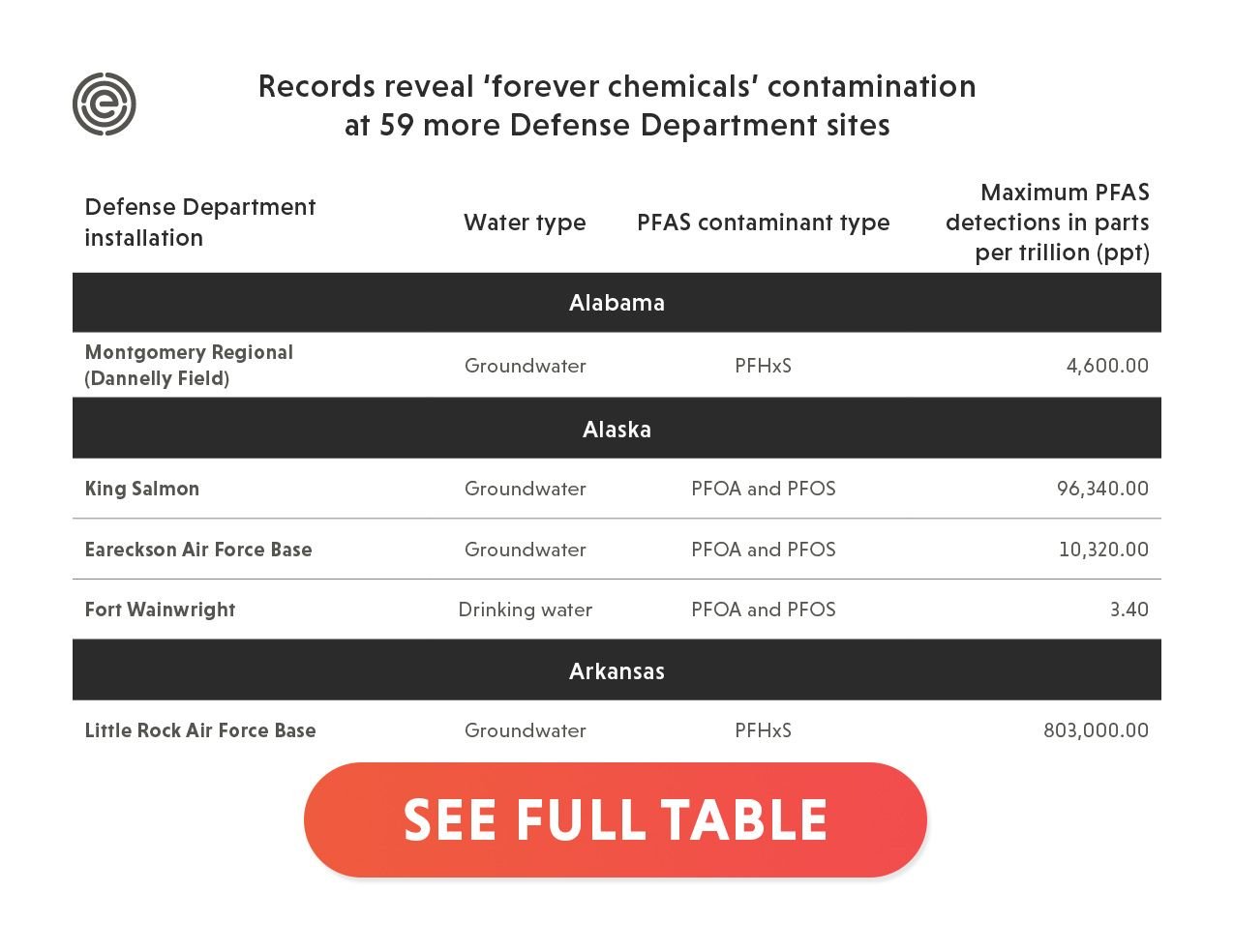WASHINGTON – The soil, groundwater and surface water of an additional 59 military installations across the U.S. are contaminated with the toxic “forever chemicals” known as PFAS, according to Defense Department records obtained by EWG. This brings the number of affected bases to 385.
The DOD records reveal PFAS levels at the 59 installations ranging from 3.4 parts per trillion, or ppt, to 870,000 ppt in the bases’ soil and water. There are no federal limits on PFAS in soil or water, but some states have moved to limit the most ubiquitous type of PFAS in drinking water to levels as low as 6 ppt in order to adequately protect human health.
In addition to the 385 sites where PFAS contamination is now confirmed, DOD’s data also show suspected contamination in groundwater at 294 additional installations.
A total of five installations identified by the new EWG analysis are among the department’s sites with the highest PFAS detections in their soil or groundwater in the country, the records show.
The highest groundwater detection was reported at Little Rock Air Force Base in Arkansas. Other bases with very high PFAS concentrations detected in their groundwater include McConnell Air Force base in Kansas, Offutt Air Force Base in Nebraska, Schriever Air Force Base in Colorado, and Beaufort Marine Corps Air Station in South Carolina.
Other DOD locations with high PFAS detections include the Washington Navy Yard, in Washington, D.C., and the Air Force Academy, in Colorado.
“Toxic PFAS are in the blood of nearly every American,” said Jared Hayes, EWG policy analyst. “Every time we test for PFAS, these forever chemicals are detected. I expect we’ll soon be confirming more military sites polluted with PFAS.”

DOD has known for years about the risks from PFAS
PFAS are known as forever chemicals because they build up in our blood and organs and do not break down in the environment. Studies show that exposure to very low levels of PFAS can increase the risk of cancer, harm fetal development and reduce vaccine effectiveness.
The primary source of PFAS contamination at military bases is aqueous firefighting film-forming foam, or AFFF, developed by DOD and 3M in the 1960s and first required by the Navy and the Marine Corps in 1967. Legacy formulations of AFFF, used for decades, contained PFOS and PFAS precursors that can break down into PFOA and other toxic PFAS.
DOD has long known about the toxic effects of PFAS pollution. In 1973, an Air Force report cited the toxic effects of AFFF on fish and recommended the use of carbon filters for drinking water to prevent contamination. Subsequent Air Force and Navy reports, in 1974, 1976 and 1978, also cited the toxic effects of AFFF on fish.
In 1983, animal studies financed by the Air Force found that some PFAS were toxic. In 1985, Navy experts again cited the toxic effects of AFFF on fish and, in 1989, called for better management of AFFF waste.
In 2000, DOD learned that 3M planned to stop making AFFF, after the company’s internal studies showed evidence of its health hazards. A 2001 DOD memo concluded the main ingredient in AFFF was “persistent, bioaccumulating, and toxic.” Months later, an Environmental Protection Agency official reiterated to the DOD the risks posed by PFOS and the entire class of PFAS.
But DOD officials waited another decade to issue a risk alert to service members and did not take steps to replace AFFF until 2015 – despite a 1991 Army Corps of Engineers recommendation to use nonhazardous substitutes.
“DOD knew about the potential risks of these chemicals for years and did not act,” said Hayes. “And now hundreds of bases have high levels of PFAS contamination.”
Congress to take up long overdue critical reforms
Newer PFAS in replacement foams have been linked to many of the same health effects as those linked to PFOS, leading lawmakers in Congress to require DOD to phase out the use of fluorinated foams altogether.
And last month, DOD's inspector general faulted the department for moving too slowly to address the PFAS contamination crisis, underscoring the urgency needed to address the issue.
Earlier this summer, the Senate Armed Services Committee included provisions in the National Defense Authorization Act for fiscal year 2022 that would set deadlines for PFAS testing and reporting at DOD sites but without setting deadlines for cleanups. The House Armed Services Committee will take up its version of the bill in September.
###
The Environmental Working Group is a nonprofit, non-partisan organization that empowers people to live healthier lives in a healthier environment. Through research, advocacy and unique education tools, EWG drives consumer choice and civic action. Visit www.ewg.org for more information.



